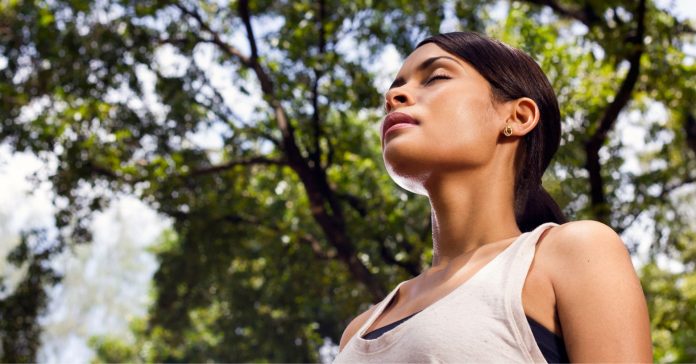Breathing is an automatic bodily function that we tend to take for granted unless an issue arises. From the moment we’re born, we instinctively know how to breathe, and many people go about their daily lives without giving it a second thought. However, breathing efficiently requires the coordinated effort of the lungs, diaphragm, and intercostal muscles, according to a pulmonologist. When one of these components isn’t functioning properly, breathing can become labored. It’s only when we experience problems like asthma, breathing conditions, or panic attacks that we become aware of our breath. In this article, we’ll explore the importance of breathing, warning signs of dysfunctional breathing, and tips on how to maintain healthy lungs and improve your breathing.
Signs you’re breathing wrong
While breathing is a natural process that occurs without conscious thought, there are certain red flags to be aware of, according to an allergist and immunologist. If you experience difficulty taking a deep breath, gasping for air, or struggling to finish sentences due to breathlessness, it may indicate a breathing problem. Additionally, coughing or wheezing can also be warning signs of trouble. Being mindful of these symptoms can help you identify potential issues and seek medical attention if necessary.
1. You overthink your breathing
According to a head and neck surgeon, one common error people make is overanalyzing their breathing. This can lead to unnecessary anxiety and even trigger shortness of breath. Remember, breathing is an innate process that you’ve been doing effortlessly since birth. Have faith in your body’s ability to breathe naturally and avoid overthinking it – you’re already an expert at it!
2. You mostly breathe through your mouth
Another common mistake is breathing through your mouth instead of your nose, which can lead to issues. Nasal breathing is ideal as it filters out toxins, and allergens, and humidifies the air. Mouth breathing, done by 30-50% of adults, especially in the morning, increases the risk of dry mouth and potentially life-threatening asthma. However, mouth breathing may be necessary for those with nasal obstructions due to allergies, sinus infections, or nasal polyps. If you struggle to breathe through your nose most of the time, consult an ENT specialist to address the underlying issue.
3. You don’t exhale completely during exercise
During exercise, people often tense their shoulder and neck muscles, restricting their breathing efficiency. To improve this, a simple solution is to focus on nasal inhalation and oral exhalation while working out. By consciously breathing in through your nose and out through your mouth, you can achieve balanced respiration and optimize your breathing efficiency during exercise.
4. You have poor posture
Slouching or poor posture can compress the chest cavity, restricting the diaphragm and intercostal muscles’ movement, leading to shallow or rapid breathing instead of deep, full breaths. By maintaining an upright posture, you can improve your breathing efficiency and take slower, deeper breaths that fill your lungs more effectively.
5. You suck your belly in when you breathe
Sucking in your stomach while breathing restricts the diaphragm’s movement, limiting airflow. To avoid this, relax your abdominal muscles, allowing your body to expand naturally during inhalation. When you breathe in, your rib cage and belly should expand outward, and as you exhale, your belly should retract inward. To check your technique, place your hand on your belly; it should move outward as you inhale and inward as you exhale. This ensures you’re breathing efficiently and getting enough air.
6. You breathe in pollution
Many people unwittingly breathe in air pollution, even in their own homes. This can lead to airway irritation and reduced oxygen transport from the lungs to the blood. To avoid this mistake, it’s crucial to be aware of the air quality both inside and outside and strive to be in well-ventilated, clean environments. Consider using an air purifier to minimize your exposure to air pollution and promote healthier breathing.
How to breathe better
Improve your breathing by identifying and correcting common errors. Pay attention to your posture, breathe nasally, and address the additional mistakes mentioned earlier. By making these simple adjustments, you can develop healthier breathing habits and enhance your overall well-being.
Once you’ve done that, you can consider the following steps, which will help you breathe easier.
1. Exercise regularly
A healthy lifestyle is the key to proper breathing. Regular exercise not only boosts lung capacity, allowing for more efficient oxygen intake but also helps with weight management. Maintaining a healthy weight is crucial, as excess weight can restrict lung expansion and increase the risk of breathing conditions like obstructive sleep apnea, exacerbating symptoms. By prioritizing a healthy lifestyle, you can optimize your breathing and overall well-being.
2. Don’t smoke
Avoiding smoking is crucial to improve lung health, as it can severely damage lungs and hinder oxygen absorption into the bloodstream. Smoking is a significant risk factor for Chronic Obstructive Pulmonary Disease (COPD), a progressive lung disease that causes shortness of breath, fatigue, and wheezing. COPD, which includes emphysema, affects nearly 400 million people worldwide, with many more potentially undiagnosed. Quitting smoking and minimizing exposure to pollutants can help protect lung health and prevent COPD.
3. See your doctor for any issues
It is important to seek professional help if you suspect you have airborne allergies. Getting tested, diagnosed, and treated by an allergist can make a significant difference. Uncontrolled allergies and asthma can lead to chronic lung inflammation, scarring, and even fatal consequences. Additionally, if you experience persistent nasal congestion or shortness of breath, don’t hesitate to consult your doctor. Taking control of your symptoms and seeking medical attention can help prevent long-term damage and ensure effective management of your condition.


